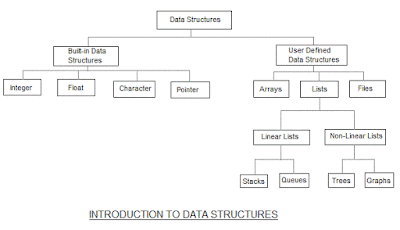Data Structures
Data Structures
Introduction :
Data Structure is a way of collecting and organizing data in such a way that we can perform operations on these data in an effective way.
Data Structures is about rendering data elements in terms of some relationship, for better organization and storage.
For example,
we have a data player's name "Vaishno" and age 20. Here "Vaishno" is of String data type and 20 is of the integer data type.
We can organize this data as a record like Player record.
Now we can collect and store player's records in a file or database as a data structure.
For example: "Mayank" 22, "Rigved" 19, "Banti" 17.
In simple language, Data Structures are structures programmed to store ordered data, so that various operations can be performed on it easily.
It represents the knowledge of data to be organized in memory.
It should be designed and implemented in such a way that it reduces the complexity and increases the efficiency.
Basic types of Data Structures:-
As we have discussed above, anything that can store data can be called a data structure, hence Integer, Float, Boolean, Char, etc, all are data structures.
They are known as Primitive Data Structures.
Then we also have some complex Data Structures, which are used to store large and connected data. Some example of Abstract Data Structure are :
- Linked List
- Tree
- Graph
- Stack,
- Queue etc.
We will look into these data structures in more detail in our later lessons.
The data structures can also be classified on the basis of the following characteristics:-
Characteristic: Description
Linear:
In Linear data structures, the data items are arranged in a linear sequence.
Example: Array
Non-Linear:
In Non-Linear data structures, the data items are not in sequence.
Example: Tree, Graph
Homogeneous:
Inhomogeneous data structures, all the elements are of the same type. Example: Array
Non-Homogeneous:
In the Non-Homogeneous data structure, the elements may or may not be of the same type.
Example: Structures
Static:
Static data structures are those whose sizes and structures
associated memory locations are fixed, at compile time.
Example: Array
Dynamic:
Dynamic structures are those which expand or shrinks depending on the program's need and its execution.
Also, their associated memory locations changes.
Example: Linked List created using pointers.
What is an Algorithm?
An algorithm is a finite set of instructions or logic, written in order, to accomplish a certain predefined task.
An algorithm is not the complete code or program, it is just the core logic(solution) of a problem, which can be expressed either as an informal high-level description as pseudo code or using a flowchart.
Every Algorithm must satisfy the following properties:
Input- There should be 0 or more inputs supplied externally to the algorithm.
Output- There should be at least 1 output obtained.
Definiteness- Every step of the algorithm should be clear and well defined.
Finiteness- The algorithm should have a finite number of steps.
Correctness- Every step of the algorithm must generate the correct output.
An algorithm is said to be efficient and fast if it takes less time to execute and consumes less memory space. The performance of an algorithm is measured on the basis of the following properties :
Time Complexity.
Space Complexity......
Guide by "ISRD Group" Download.
Check your knowledge Question Bank.
SHARING IS CARING || MOHMYAWORLD
LIKE || SHARE || COMMENT
----------------------THANK YOU-----------------------------
*********************Visit Again***********************






No comments: